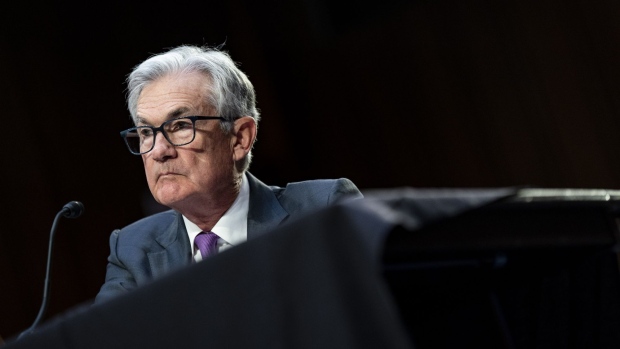Mar 7, 2023
Economists See Larger March Rate Hike After Powell’s Remarks
, Bloomberg News

(Bloomberg) -- US economists see higher odds that the Federal Reserve could re-accelerate the scale of its rate increases this month after Chair Jerome Powell spoke before Congress on Tuesday, with some emphasizing it will depend on the strength of incoming data.
Powell said in testimony before the Senate Banking Committee that the US central bank is likely to lift interest rates higher and potentially faster than previously anticipated.
“The latest economic data have come in stronger than expected, which suggests that the ultimate level of interest rates is likely to be higher than previously anticipated,” Powell said. “If the totality of the data were to indicate that faster tightening is warranted, we would be prepared to increase the pace of rate hikes.”
Some economists took his remarks as a sign that the Fed is more likely to take a bigger move at the March 21-22 meeting, though some Fed watchers are still expecting the central bank to roll out a more incremental 25 basis-point hike. Policymakers will have a chance to review the February jobs report and an update on consumer prices before they meet again.
Investors now see a 50 basis-point increase as the most likely outcome, according to pricing in futures contracts. Here’s what some economists are saying:
- “We now think the FOMC will hike 50 basis points at the March meeting (to 5.1%),” economists for LH Meyer wrote in an email note Tuesday morning. “Powell’s comments make it sound as though they need to be convinced not to speed the pace up. The presumption that’s been established is that they will hike 50 in March, unless they are convinced otherwise.”
- “Fed chair Powell’s prepared testimony to Congress is more hawkish than we had anticipated and risk-off,” wrote Krishna Guha and Peter Williams of Evercore ISI. “We do not think this means that a 50bp rate hike in March is likely and continue to believe it would require very hot February data such that the estimated peak rate would move up 50bp rather than 25bp.”
- “At this time, I am sticking to my call for a 25 BP rate hike on March 22,” wrote Stephen Stanley, chief US economist for Santander US Capital Markets. “I still believe that the bar is high for the Fed to reverse field and increase the magnitude of its rate moves. Nevertheless, there is no question that Powell opened the door to a 50 BP hike in March.”
- “We now expect the dots tracing Powell’s expected path of policy rates – and those of multiple other committee members — to shift higher and stay higher for longer,” wrote Anna Wong and Stuart Paul, economists for Bloomberg Economics. “He also opened the door at some point to a 50-basis-point hike – or ‘faster tightening’ — if the ‘totality of the data’ warrant it. We read that as suggesting data so far aren’t enough to support a 50-bp hike, but February’s jobs report (due March 10) and CPI report (due March 14) could be the decisive data points.”
©2023 Bloomberg L.P.






